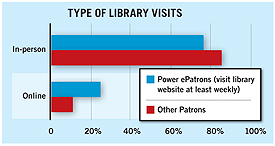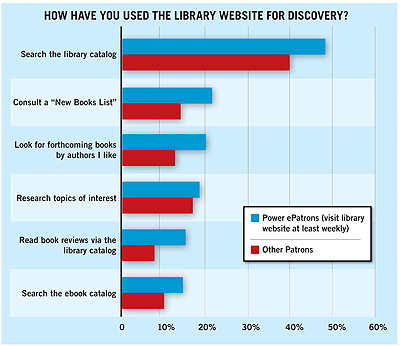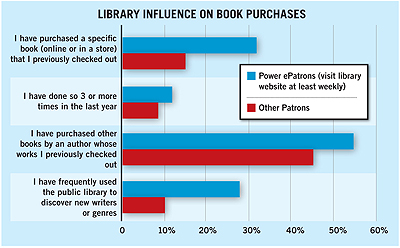“Library Websites and Virtual Services,” LJ’s latest report in its ongoing Patron Profiles series, found that libraries’ most devoted e-users aren’t choosing using the web over coming to the library in person. Rather, they are choosing to do both.
For this edition of Patron Profiles, LJ, in conjunction with Bowker PubTrack Consumer, surveyed 2,005 U.S. residents aged 18 and over. Steve Paxhia, president, Beacon Hill Strategic Solutions, and technical writer John Parsons again analyzed the results, creating a new category of library user: the Power ePatron. Just as the Power Patrons of LJ’s previous Patron Profiles visit their library weekly, Power ePatrons visit their library’s website at least once a week. Some 17% of those sampled are Power ePatrons. [For more on Patron Profiles, see www.thedigitalshift.com/research/patron-profiles.]
 While one might expect from all the hype about whether libraries are becoming obsolete that these heavy Internet users never set foot in a physical library, it turns out that the opposite is true. Not only are 56% of Power ePatrons also on-site Power Patrons, but Power ePatrons still prefer an on-site library visit to an online one. In fact, Power ePatrons borrow more media, place more holds, and pick up reserve books more often than other patrons. The only area in which they lag is shelf browsing/impulse discovery—also identified as an area for development of online services.
While one might expect from all the hype about whether libraries are becoming obsolete that these heavy Internet users never set foot in a physical library, it turns out that the opposite is true. Not only are 56% of Power ePatrons also on-site Power Patrons, but Power ePatrons still prefer an on-site library visit to an online one. In fact, Power ePatrons borrow more media, place more holds, and pick up reserve books more often than other patrons. The only area in which they lag is shelf browsing/impulse discovery—also identified as an area for development of online services.
LJ research manager Laura Girmscheid says, “There is very strong overlap [between Power Patrons and Power ePatrons], but not completely.” She explains that those who are both Power Patrons and Power ePatrons are “more likely to attend library programs and reading groups and ask reference questions.”
Alison Circle, recently promoted to chief customer experience officer at the Ohio’s Columbus Metropolitan Library (CML) (and LJ’s Bubble Room marketing blogger), serves on the Patron Profiles advisory board. She told LJ that in her library’s experience, “There is a segment that only comes in to pick up reserves. There is a segment who participate in the other services of the library, including job help, homework help, and story times…. Our challenge is to reinvent value in libraries…so that tomorrow, when more offerings require download not pickup, we continue to be relevant to our communities.”
According to LJ’s Girmscheid, Power ePatrons are more likely to be African American, Asian, and Hispanic and to have a baby or toddler at home; 42% of Power ePatrons have a household income of $50,000–$90,000.
What they want from the website
Power ePatrons visit the library website and the library itself for different reasons. Online, Power ePatrons want to do specific things quickly: place holds, check due dates, renew books, arrange loans, pay fines, download ebooks, and search the catalog. Like most patrons, they’re more likely to search for a specific item than to read librarians’ recommendations.
 Therefore, essential website information includes hours, programs, branch locations, and other information about in-person activities; collection information, including availability and reviews; research tools, including access to reference librarians; and personal data such as borrowing history. Website design should be clean, simple, easy to navigate, and employ plain language rather than library-specific terminology. (As John Kupersmith, reference librarian at the University of California–Berkeley, writes in his paper “Library Terms That Users Understand,” words like database, library catalog, interlibrary loan , periodical, serial, and reference are commonly misunderstood. Common correctly understood terms include find books , find articles, and other combinations using natural-language target words that correspond to the end product the user is seeking.)
Therefore, essential website information includes hours, programs, branch locations, and other information about in-person activities; collection information, including availability and reviews; research tools, including access to reference librarians; and personal data such as borrowing history. Website design should be clean, simple, easy to navigate, and employ plain language rather than library-specific terminology. (As John Kupersmith, reference librarian at the University of California–Berkeley, writes in his paper “Library Terms That Users Understand,” words like database, library catalog, interlibrary loan , periodical, serial, and reference are commonly misunderstood. Common correctly understood terms include find books , find articles, and other combinations using natural-language target words that correspond to the end product the user is seeking.)
Rebecca T. Miller, School Library Journal editor in chief and the editor of the Patron Profiles series, advises, “Start incremental change if you can. Don’t think you have to have a master plan. Make your search box more accessible if it is small. Be conscious that your users need to get things done quickly. Look at your website with fresh eyes, thinking of discovery of content and ease of access in terms of the process of reserving materials and handling materials. Test it yourself. Think of the website as a welcome point. It can be simple; it just has to be usable.”
As far as concrete, easily implemented suggestions to get started, Miller suggests “real no-brainers: Can they call the library easily? Is the director’s name on the website? Is the organization transparent? Can they find help without filling out a form? If they do fill out a form, is anyone actually responding?”
 Many libraries still have a lot of work to do on those basics—only 32% of those surveyed rated their library as excellent for finding basic library information. But for those more advanced, respondents were very interested in alerts about books by favorite authors, the number of prior holds (and how many copies available), the ability to rank holds by desire, and automatic reserves for favorite authors.
Many libraries still have a lot of work to do on those basics—only 32% of those surveyed rated their library as excellent for finding basic library information. But for those more advanced, respondents were very interested in alerts about books by favorite authors, the number of prior holds (and how many copies available), the ability to rank holds by desire, and automatic reserves for favorite authors.
“Historically, our website was conceived and built based on what library staff thought was good for customers. This new site is designed for our users to determine that for themselves,” says Columbus’s Circle. “With a login, users customize their content to reflect their interests…. Throughout the next year, we will continue to add more options to this personalization, which will be capped with the introduction of a new ILS.”
Library to go
While mobile access to library websites is lagging very frequent visitors are most likely to use tablets, at 21%, and less likely to use smartphones and ereaders. Active Readers, on the other hand (those who read 15 or more books per year), prefer ereaders over tablets. Still, as mobile use becomes more ubiquitous, optimizing websites for mobile access will become more important for both groups.
Barbara A. Genco, Patron Profiles project manager, says the survey findings “validate some hypotheses we had…. We were convinced that libraries need to pay more attention to their mobile presence and spend more time on either a mobile app or a website that can be easily accessed from a mobile device.”
CML has invested in both. “Our customers access us through multiple platforms,” says Circle. “To be relevant, we need to meet our customers wherever and however they are.”
Borrowing leads to book buying
Not surprisingly, ebooks are Power ePatrons’ favorite type of media. Some 25% have already borrowed ebooks, more than twice the number of other patrons who have done the same. However, Patron Profiles data refutes the assertion of Anthony Marx, president and CEO of the New York Public Library, who said at the Association of American Publishers annual meeting, “Those who can afford to buy books quickly and easily do so. Those who cannot, put up with some inconvenience to come to the library.” In fact, Power ePatrons are slightly more affluent than other patrons, as well as more likely to have graduated from college. (They’re also more likely to be female and younger, at 21–40.)
Not only can they afford to buy books, they do buy them. Power ePatrons are especially likely to buy books based on their library activities, as are Active Readers. (That’s a lot of purchases: Active Readers buy about 20 books per year.) Almost one quarter (23%) of Power ePatrons are also Active Readers, as are 34% of in-person Power Patrons.
Only the beginning for the power epatron
Jamie LaRue, director of Douglas County Libraries, CO, said on a recent library design tour that no matter how great a library’s architect and design are, things are changing so fast in librarianship these days that it will only last 18 months before you have to change something. If anything, the rate of change online is even faster, so Patron Profiles will be tracking the trends quarterly.



. Active Readers, on the other hand (those who read 15 or more books per year), prefer ereaders over tablets.